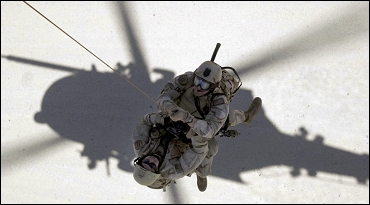
PHOTO: Pararescuemen from the 304th Rescue Squadron are hoisted up to an HH-60G Pavehawk during Operation Iraqi Freedom in April 2003 at Tallil Air Base, Iraq. (U.S. Air Force photo by Tech. Sgt. Shane A. Cuomo)

Pararescue Computer Wallpaper
1152 x 864 | 1024 x 768 | 800 x 600
Superman School
Only the strong of body & mind survive the ‘pipeline,’ the world’s toughest school
by Master Sgt. Pat McKenna
photos by Master Sgt. Dave Nolan
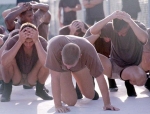 Jason Cunningham’s body begged for air. Submerged 9 feet under, the airman’s lungs prickled and burned, feeling as if they’d burst like a pair of overinflated truck tires. By reflex, his nervous system declared a state of emergency – DEFCON 1. Every instinct urged him to burst to the surface and suck in cool, fresh air.
Jason Cunningham’s body begged for air. Submerged 9 feet under, the airman’s lungs prickled and burned, feeling as if they’d burst like a pair of overinflated truck tires. By reflex, his nervous system declared a state of emergency – DEFCON 1. Every instinct urged him to burst to the surface and suck in cool, fresh air.
But he ignored the red alert blaring in his brain and stayed below for several minutes. Soon the throbbing in his chest ceased, his peripheral vision collapsed and the world around him faded to black.
Cunningham lost consciousness and sank to the bottom of the pool.
Immediately, a group of rugged men wearing black neoprene suits and scuba gear hauled him out of the pool and revived him. One of the men, who hovered over him, asked, “You OK? You OK? Did you meet the wizard?”
At the time, still reeling from the fog of delirium, Cunningham could only manage a gurgled “Huh?” but later recounted his near-death experience.
“Once you pass out the first time, you get used to it,” said the 24-year-old from Camarillo, Calif. “It’s like – it hurts, it hurts, and boom, you’re asleep. Then you wake up, some-body’s slapping your face, and you’ve got this oxygen mask covering your mouth. It’s really not that bad, no big deal.”
Excuse me – No big deal? For most people, drowning ranks pretty high in the “big deal” department, right up there with electrocution, decapitation and being buried alive. But Cunningham isn’t what you’d call most people. He’s going through the toughest school on the planet in hopes of becoming an Air Force pararescueman, also commonly called a “PJ,” which comes from the old symbol on aircrew orders for parachutist.
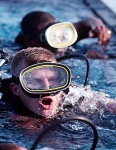 And a PJ is far from being your average Joe Six-pack. Like the Navy’s SEALs, the Marine’s Force Recon and the Army’s Green Berets, Air Force pararescuemen stake claim to being the best of the best in the military. They’re a crack fighting force – lean, lethal and lightning quick. Calling them “elite” may sound like a cliché, yet there’s no other word for it. While SEALs and Green Berets teem in the thousands, the Air Force treasures the mere 300 active-duty pararescuemen they have primed and ready for action.
And a PJ is far from being your average Joe Six-pack. Like the Navy’s SEALs, the Marine’s Force Recon and the Army’s Green Berets, Air Force pararescuemen stake claim to being the best of the best in the military. They’re a crack fighting force – lean, lethal and lightning quick. Calling them “elite” may sound like a cliché, yet there’s no other word for it. While SEALs and Green Berets teem in the thousands, the Air Force treasures the mere 300 active-duty pararescuemen they have primed and ready for action.
Cunningham, a former Navy petty officer, even considered a hitch with the SEALs, going so far as passing the grueling frogman fitness test, but had a change of heart after his tryout.
“I didn’t want to kill people. I want to save them,” said Cunningham, now an airman first class.
Unlike other special operators, who search and destroy, PJs “search and save.” Think of them as SEALs with stethoscopes. They’re extreme emergency medical technicians, a kind of cross between Schweitzer and Schwarzenegger. In a pinch, a PJ is a pilot’s best friend, and the bad guy’s worst enemy, just as accurate with a 9mm pistol as he is with a syringe. One minute, you might find these Rambos of resuscitation subduing an enemy patrol and the next, jump-starting a heart with a pair of defibrillator paddles.
Most of these ninja paramedics belong to combat search and rescue teams, where they’re charged with locating downed aircrews behind enemy lines, patching them up and spiriting them away to safety. If given a choice, PJs prefer avoiding confrontation. It’s too messy.
“We’re not about death and destruction, and blowing stuff up. We want to get in and get out … no fuss, no muss,” said Master Sgt. Craig Guthridge, a veteran PJ and director of operations for the Pararescue School at Kirtland Air Force Base, N.M. “But we’re not going to raise the white flag the first time the enemy says ‘boo!’ either. We’re just as skilled in taking lives as we are at saving them. And sometimes you have to do bad stuff to get the good guy out.”
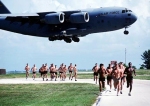
Sink or swim
Gaining admittance into this exclusive fraternity (law excludes women from volunteering) demands that pararescue candidates endure a two-year long initiation ritual called the “pipeline” – a gauntlet of coursework and instruction taught at military bases scattered across the country. It’s a killer curriculum; about 90 percent of the applicants wash out. And most don’t even make it past the entrance exam – a physical fitness test that’d have your average jock doubled over wheezing.
Pararescuemen shatter the stereotype popular among other services that airmen are cream puffs living a pampered existence and whose idea of roughing it is sharing a room at the Hotel Intercontinental.
“I love to see the Army guys gain an appreciation of the Air Force. Most of them think we’re a bunch of wussies, that is, until we pass them in the pool,” said Master Sgt. Steve Sanko, a pararescue instructor at the Army’s combat divers school in Key West, Fla.
Well, not all think that way. One Army Special Forces sergeant major, who asked not to be identified, said, “PJs are the best trained special ops forces in the Defense Department – bar none – but you’ll never hear me admit that in public.”
The philosophy behind the rigorous regimen boils down to this – the more you sweat in training, the less you bleed in combat. And by the time a PJ pledge finishes plodding through the pipeline, he’s sweated an ocean. In the process, he’s become an expert marksman, accomplished parachutist, mountain climber, scuba diver and a certified emergency medical technician.
While riding the pipeline, he’s learned to whoosh down a 30-foot fast rope from a hovering helicopter. He’s scaled sheer rock faces and traversed craggy cliffs at elevations that’d give a mountain goat a nosebleed. He’s parachuted on moonless nights into choppy seas while lugging on his back an 80-pound rucksack containing a portable operating room. And he’s braved a witches’ brew of climates and conditions, surviving in the wild on his wits and own devices.
“Although you can never really simulate combat, the pipeline is very adept at preparing you for the real deal. All the training they throw at you, all the ‘PT,’ the stress, both physical and mental, everything you go through is as close as it gets,” said Staff Sgt. Jeremy Hardy, a PJ, who dodged flak and missiles last year during a rescue mission in Bosnia.
Gut check
Pushing the envelope of human endurance emerges as a central theme in pararescue training. At every stage of the pipeline, your body and mind get taxed to its breaking point – to the very brink of total collapse – and you must find somewhere deep within yourself the grit to forge ahead, even when every sinew screams “uncle.”
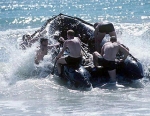 And nothing tests a man’s mettle more than the first hurdle in the pipeline – the 10-week Pararescue/Combat Control Indoctrination Course at Lackland AFB, Texas. Indoc reveals early on who’ll throw in the towel when faced with adversity. But better to find out now that a man’s fainthearted before he’s squirming at the end of a hoist while bullets whistle past.
And nothing tests a man’s mettle more than the first hurdle in the pipeline – the 10-week Pararescue/Combat Control Indoctrination Course at Lackland AFB, Texas. Indoc reveals early on who’ll throw in the towel when faced with adversity. But better to find out now that a man’s fainthearted before he’s squirming at the end of a hoist while bullets whistle past.
“We want to break the students down, crack them open, and peek inside them to see what they’re made of,” said Sanko, the scuba instructor. “We want to find out how they’ll react after missing 24 hours of sleep, when they’re totally spent, sore and hungry, when they’re humping that rucksack up the side of the mountain in the cold and rain. We want to find out if they’re quitters. Without drive and determination, you’ll fail the mission. If you fail in the pool, no problem, we’ll drag you out and send you home. But fail on a mission and you come home in a body bag. Maybe your whole team comes home in body bags.”
Master Sgt. Tim Wilkinson, a PJ who’s landed in more hotspots than a Tom Clancy character, said, “Indoc is a gut check. We want to know if you’re the type of person who’ll stick it out when the chips are down.”
Indeed, the course makes workouts at boot camp look like a sixth-grade phys ed class. The pain commences at 4:30 a.m. and doesn’t end until well after sunset. Students double-time through a daily routine of circuit training on weight machines, swimming, running, and huffing and puffing through 50-odd combinations of calisthenics with names like cherry pickers, steam engines and mountain climbers. By the time they reach the end of the second month, trainees must crank out – in perfect form, mind you – 70 push-ups, 75 sit-ups, 13 pull-ups, 14 chin-ups and 85 flutter kicks, each within two minutes and with little rest in between. They must also run six miles within 45 minutes, swim 50 meters underwater on a single breath, and swim 4,000 meters on the surface under 80 minutes.
For an extra sock in the solar plexus, the schoolhouse staff convenes frequent “smoke sessions,” which are punishing marathon workouts that make recruits “feel the burn.” Also, committing the most miniscule infraction merits your entire flight “getting dropped” for a set of 50 remedial push-ups plus extra reps dedicated to every instructor in the area and another for the pararescue corps. It’s not unusual for the group to pound out 800 or a thousand push-ups in a day. The administration calls it “teambuilding,” and if they think a class isn’t functioning as a single, motivated unit, they heap on another incentive to bond – lugging around a 450-pound piece of iron railroad track called the “rail” between classrooms and sites.
“When I arrived at indoc, I thought I was in shape but found out within the first five minutes I wasn’t in ‘PJ’ shape,” said Airman 1st Class Adrian Durham, a 22-year-old former lifeguard from Hartford, Conn., now in the pipeline. “To keep myself going during the smoke sessions, I told myself the pain’s got to end sometime. Then at some point, your muscles become so numb you just stop caring.”
All these drills, however, serve only to warm up recruits for the persecution in the pool. Officials have dubbed the pool sessions “water confidence training,” which is like calling a beating with a baseball bat “hickory familiarization.” The water weeds out more candidates than any other activity. There’s something about inhaling a lung-full of pool water that saps a man’s resolve, prodding him to question his commitment.
 Between indoc and combat divers school in Key West, students spend more time performing in the pool than Shamu, but without the pleasure of drenching onlookers. Instead, the waterlogged warriors slosh around wearing 16-pound weight belts; tread water; tie knots at the bottom of the pool; and swim and bob with bound feet and hands during an exercise called drownproofing. For many, buddy breathing makes or breaks them. The drill pairs two students, who must share a snorkel for several minutes while instructors splash, harass and dunk them. Surface more than once to gasp for breath and you fail.
Between indoc and combat divers school in Key West, students spend more time performing in the pool than Shamu, but without the pleasure of drenching onlookers. Instead, the waterlogged warriors slosh around wearing 16-pound weight belts; tread water; tie knots at the bottom of the pool; and swim and bob with bound feet and hands during an exercise called drownproofing. For many, buddy breathing makes or breaks them. The drill pairs two students, who must share a snorkel for several minutes while instructors splash, harass and dunk them. Surface more than once to gasp for breath and you fail.
“To an outsider, the training may look abusive or like hazing,” Sanko said. “But if you panic on a real dive and shoot to the surface, you may explode a lung or get the ‘bends.’ The ocean is very unforgiving, and at least here, we give you two chances.”
Men of steel
For those steely and stout enough to survive the first few weeks of indoc, Motivation Week looms. It’s a feared and fabled rite of passage, the Air Force’s version of SEAL Hell Week. During this ultimate test, black-shirted instructors prowl the ranks, dispensing less mercy than the Terminator doing a drive-by, spraying students with icy jets of water from a garden hose and barking orders at the airmen, who all seemed to be named “you.” “Get off that wall, you!” “Hey, you! Keep those legs straight!” “You want to quit, you? Then quit!”
Regardless of the circumstances, students answer every question with the same response “”Hoo-yah!” which is a catch-all phrase meaning everything from “yes” and “no” to “You talking to me?” and “Please, make the pain stop!”
Said Cunningham: “Motivation week is downright evil. It’s ugly … chaotic. It’s nonstop training, constant screaming, smoke sessions one after the other, and only a couple hours of sleep a night. When you finally get a chance to put your head on a pillow at night, you’re out in seconds.
“Thinking of my family motivated me to suck it up and press on. I have a wife, a daughter and another on the way who’ve sacrificed a lot for me to be here,” the airman said. “They’re counting on me, and I’m going to earn it for them. Plus, I’ve had my butt kicked too many times to give up. Anybody who has ever quit regretted it the next day. I don’t want to be that guy.”
According to instructors, it’s impossible to predict, at first glance, who’ll stay the course and graduate. Naturally, you’d expect those muscle-bound troglodytes, who dwell in the free weight rooms of gyms, to have a good shot at making the grade, but that’s not usually the case. Because of low body fat, these hulks usually sink faster than a snitch in a cement overcoat.
“It doesn’t make a difference if you’re an NCAA swimmer or some big, buff stud. You’ve got to have smarts and a heart – the total package,” Sanko said. “Usually, it’s the mean little dog who makes it through.”
Wilkinson agrees that success is often a matter of mind over muscle. “Pararescue is a thinking man’s game. You can’t be ‘strong like bull, smart like tractor,’ ” he said.
Nobody back home in Hartford ever pictured Durham as a camouflaged commando. Friends and family thought of him as a bookworm, even nicknaming him the “absent-minded professor,” because he preferred academics to athletics. They figured him for a librarian, schoolteacher or accountant.
“I fooled them,” Durham said. “I hate sitting down at a desk so when I saw the pararescue brochure at the recruiter’s office, I said this is the ticket. I can be a high-speed operator – skydiving, scuba diving, rock climbing, ice climbing – all the things I could never do before because I couldn’t afford them. And now they’ll pay me for it.”
Although PJs receive extra pay for their special duties, none concede they’re in it for the money. Most admit they’re adrenaline junkies, ‘jonesing’ for challenges, adventures and the “rush” that a 9-to-5 grind couldn’t offer. Others cite compassion for their fellow man, patriotism, and the pararescue corps’ esteemed and legendary heritage for volunteering.
Of the 21 Air Force Crosses given to enlisted men for extraordinary heroism, 11 were awarded to para-rescuemen. During the Korean War, PJs plucked pilots out of the frigid Sea of Japan; extricated aircrews from the jungles of Vietnam; rescued Rangers during a bloody firefight on the streets of Mogadishu, Somalia; and saved the skin of several airmen during the most recent conflict in Kosovo. Furthermore, PJs pitched in during the SS Mayaguez rescue mission off Cambodia’s coast in 1975, raided the North Vietnamese Song Tay prison camp in 1970, helped evacuate Saigon, recovered astronauts on Gemini and Apollo missions, and continue to provide support for NASA shuttle launches and landings.
Today’s generation of pararescuemen share much with their PJ patriarchs. They both possess a tight-jawed tenacity, a stubborn will to never surrender, and a competitive spirit that’d turn a game of solitaire violent.
Look! Up in the sky!
You see the same fire burning brightly in the eyes of the new breed of PJs like Staff Sgt. Doug Isaacks. The 25-year-old native of Anaheim, Calif., just wrapped up his two-year trial through the pipeline last September. When he initially applied for retraining into the pararescue field while a cop at Dyess Air Force Base, Texas, more than a few of his contemporaries at the security forces squadron scoffed at him, telling him he’d most certainly fail and betting he’d be back patrolling the perimeter within weeks.
“All I heard were the statistics, the high washout rates, like only one in a hundred makes it. Nobody gave me much of chance,” said Isaacks, who looks as strong as a Clydesdale. “But I did it, and it’s one of the greatest moments of my life. It feels great to be part of something special – a brotherhood. It’s also changed me as a person, boosting my self-esteem and my confidence. I know now that I’ll never quit no matter what.”
Last September, Isaacks left for his first pararescue assignment at a special tactics unit at Hurlburt Field, Fla., but a pressing matter delayed him. He first had to drop by Dyess so he could strut through his old squadron sporting his new maroon beret. It’s not that he wants to rub it in that everybody underestimated him, but he told you so.
And who’s going to argue with a PJ?
(Source: Airman Magazine)
Pararescue Apprentice
When an injured soldier is down, the Pararescue Apprentice must penetrate hostile areas to rescue and recover the survivor. Specializing in Air Force and Special Operations Combat Search and Rescue/Personnel Recovery, Pararescuemen provide specialized aerospace rescue and recovery support for NASA’s Space Shuttle flights. This career field is restricted to males. Pararescuemen are certified scuba divers and skilled in surface water operations – both scuba and amphibious. They are trained Combat Medics and certified Emergency Medical Technician Paramedics (EMT-P). As a Pararescue Apprentice, you will also learn to perform emergency medical procedures in the field to correct life-threatening conditions.
Pararescue Tech Schools:
Lackland AFB, TX; Fairchild AFB, WA; Kirtland AFB, NM; Hurlburt Field, FL; Key West, FL; Yuma Proving Grounds, AZ; Ft. Benning, GA; Jacksonville NAS, FL
Training Like They Fight
Before a candidate can claim the title pararescueman and earn the right to wear the maroon beret, he’ll spend anywhere from 18 to 24 months learning the basics of his craft. The combat curriculum consists of courses taught by Army and Air Force special operators, and boasts one of the most arduous training regimens in the military, producing the world’s most highly skilled warriors. The program, nicknamed the “Pipeline,” includes the following courses:
Pararescue/Combat Control Indoctrination Course, 10 weeks, Lackland AFB, Texas. Both students and instructors agree that if you tough out “indoc,” you’ll likely slog your way through the rest of pipeline. That’s because indoc is like Ironman 101. It’s a two-month-long triathlon of training: a sadistic routine of running, swimming and calisthenics that eliminates those mentally and physically unprepared for the rigors of the job. Much of the course concentrates on pool work – weightbelt swims, water treading, buddy breathing and drownproofing. It’s a trial by water that gives students confidence in the deep, readying them for scuba school.
U.S. Army Special Operations Underwater School, four weeks, Key West, Fla. Pararescue candidates sink to new depths, becoming combat divers and earning their “bubble” badge during this course, teaching students to “dive!, dive!, dive!” Pool week runs the first seven days, and to some, may look like water torture. If you survive treading water with a 16-pound belt or bobbing for precious breaths with your hands tied behind your back with feet bound, instructors then tie knots in your regulator hose, tear off your mask and harass you underwater. Next, students learn to infiltrate hostile waters, navigate by compass and to survive equipment failure at murky depths while using scuba and closed-circuit rebreathing gear. To pass the course, pararescuemen must complete a 3,000-meter underwater navigation swim.
U.S. Navy Underwater Egress Training, one day, Pensacola Naval Air Station, Fla. After scuba school, underwater egress must feel like playtime in the kiddy pool. This course instructs aircrews to escape a sinking aircraft by strapping them into a “dunker,” which is dropped into a bone-chilling pool and immediately flipped upside down. Students must quickly unbuckle themselves and swim out. According to pararescue lore, sailors have had to coax a few showoffs out of the dunker, after they’ve stayed submerged several minutes holding their breath.
U.S. Army Airborne School, three weeks, Fort Benning, Ga. Pipeline students learn to leap before they look, overcoming their innate fear of jumping out of perfectly good aircraft. During the course, pararescuemen learn “mass exit” techniques, make five parachute jumps using a static line, and receive their “jump” wings.
U.S. Air Force Survival School, two and half weeks, Fairchild AFB, Wash. Pararescue recruits “learn to return” after an aircraft bailout or crash. The course instructs aircrews to evade and escape the enemy, and if captured, resist. Students spend a week in the field, living off the land with only the meager equipment and supplies in their rucksacks.
U.S. Army Military Freefall Parachutist School, five weeks, Fort Bragg, N.C., and Yuma Proving Ground, Ariz. This more advanced parachutist course teaches pipeline pupils to freefall from high altitudes with mini-oxygen bottles. Students learn body stabilization techniques in a wind tunnel, how to rig and repack parachutes, recognize hypoxia (oxygen starvation), mass exits, night operations and make 30 freefall jumps.
Special Operations Combat Medic Course, 22 weeks, Fort Bragg, N.C. Students get hands-on training on how to patch up the wounded, learning advanced first aid, trauma medicine, triage, evacuation, minor field surgery and airway management. The course culminates on the streets of New York City, where students learn to treat stab and gunshot wounds. Graduates earn emergency medical technician certification from the National Registry.
Pararescue Recovery Specialist Course, 20 weeks, Kirtland AFB, N.M. This final course puts it all together, combining all their previous coursework into practical application. It’s the pararescue finishing school. Students receive advanced medical training and learn tactical movement, weapons handling, air operations, mountain climbing and aircrew recovery procedures. Before they can “blouse their boots” and don their berets, students must spend a week in the Pecos Mountains putting to use all they’ve learned during a final exam in the field.
Could You Pass the Test?
Think you’ve got what it takes to be a pararescueman? Find out by seeing if you can pass the PAST, that is, the Physical Abilities and Stamina Test. It’s sort of a special ops SAT for the pararescue pipeline. It’s the bare minimum physical requirements for acceptance into the program and to advance through all of its phases. Proctors administer the test in the order listed, and it must be completed within three hours. You get three minutes of rest between each of the calisthenics.
– Swim 25 meters underwater on one breath.
– Swim 1,000 meters sidestroke or freestyle in 26 minutes or under.
– Run 1.5 miles in under 10 minutes and 30 seconds.
– Pull off eight chin-ups in a minute or less
– Do 50 sit-ups in 2 minutes or less
– Pound out 50 push-ups in 2 minutes or less
– Complete 50 flutter kicks in 2 minutes or less
If you’re interested in taking the plunge into the pararescue career field, call the special tactics and rescue recruiting team at Randolph Air Force Base, Texas.